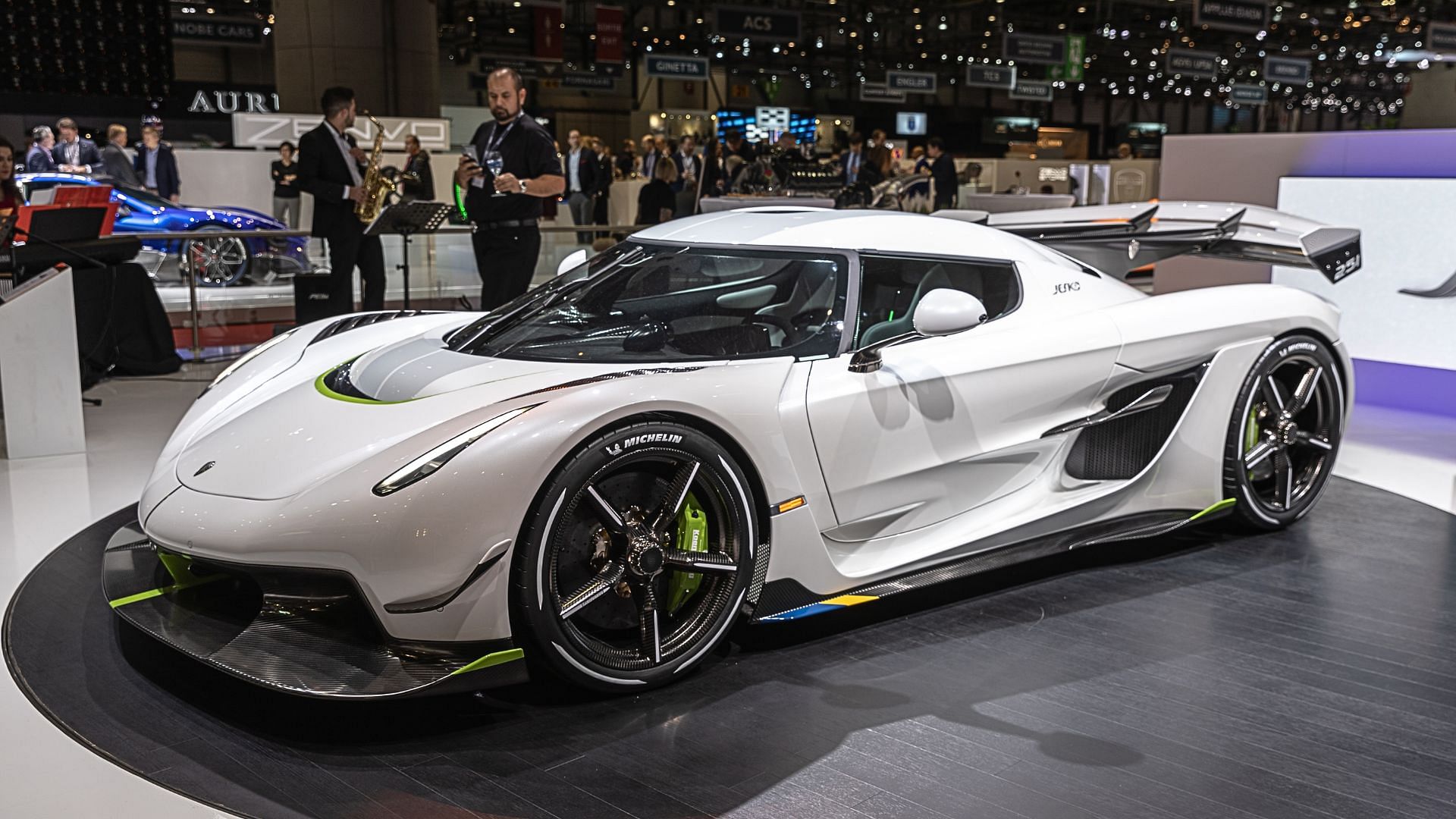Untold Stories of Koenigsegg's Legendary Hypercars and the Ghost Logo
Discover Koenigsegg's captivating journey from humble beginnings to crafting legendary hypercars. Founded in 1994 by Christian von Koenigsegg. The iconic Koenigsegg badge, based on the family's centuries-old coat of arms, reflects their heritage.
Published August 2, 2024

Table of Contents
- Know The Origin Story
- Evolution Through Innovation
- Disclosing the Ghost Logo with the Tale of the Ghost Squadron
- A Legacy of Innovation by Koenigsegg
- Conclusion
Know The Origin Story
 Koenigsegg CC Prototype - Source Valentin13580, CC BY-SA 4.0, via Wikimedia Commons
Koenigsegg CC Prototype - Source Valentin13580, CC BY-SA 4.0, via Wikimedia Commons
The story begins with a young Christian von Koenigsegg, whose love with cars was ignited by an unlikely source - the Norwegian stop-motion animated film, "The Pinchcliffe Grand Prix." At the tender age of 22, Christian embarked on an audacious mission to build his own car. With a significant investment of SKr 60,000,000 from dedicated investors, Koenigsegg Automotive was born in 1994.
Originally headquartered in Olofström, the company later relocated to Ängelholm in the early 2000s. However, a vital moment in the brand's history occurred on February 22, 2003, when one of their production facilities was caught by fire. Fearless by this setback, the Swedish brand acquired an abandoned airfield and transformed it into their cutting-edge factory.
Evolution Through Innovation
 Koenigsegg CC Prototype - Source Matti Blume, CC BY-SA 4.0, via Wikimedia Commons
Koenigsegg CC Prototype - Source Matti Blume, CC BY-SA 4.0, via Wikimedia Commons
Koenigsegg's early years were marked by relentless innovation and testing. The very first prototype, personally designed by Christian von Koenigsegg, saw the light of day in 1996. It underwent rigorous testing phases, experimenting with various engines, including an Audi V8 and a V12 engine sourced from Fiat race engine from Motori Moderni. Unfortunately, the latter deal fell through due to Motori Moderni's bankruptcy.
But this adversity only fueled their determination. In 2012, they took a daring step by basing an engine on the Ford Modular architecture. Eventually, they achieved the extraordinary - crafting entirely bespoke engines, control systems, and transmissions, a feat rarely attempted by a small sports car producer.
Disclosing the Ghost Logo with the Tale of the Ghost Squadron
 Koenigsegg Ghost Logo - Source: Cars and Culture with Jason Stein Youtube
Koenigsegg Ghost Logo - Source: Cars and Culture with Jason Stein Youtube
While Koenigsegg's primary logo exudes tradition, designed in 1994 by Jacob Låftman and rooted in the family's heraldic coat of arms dating back to the 12th century, there's another emblem that adds an aura of mystique - the Ghost Squadron Logo.
This stylized ghost symbol pays homage to the "Ghost Squadron" of the Swedish Air Force, which holds a unique place in the company's narrative. When the company moved to an abandoned airfield, the former stomping ground of the Ghost Squadron, they decided to adopt the squadron's emblem as a mark of respect.
The Ghost Squadron earned its moniker due to their dusk missions, taking off at twilight and landing under the cover of darkness. As a result, the residents nearby could hear the aircraft but never catch a glimpse of it, adding an element of mystery to their operations. This legacy inspired Koenigsegg's Ghost Logo, adorning all models produced in the converted hangar.
A Legacy of Innovation by Koenigsegg
 Koenigsegg CC850 - Source Charles from Port Chester, New York, CC BY 2.0, via Wikimedia Commons
Koenigsegg CC850 - Source Charles from Port Chester, New York, CC BY 2.0, via Wikimedia Commons
Now, let's get up close with the extraordinary models that have emerged from Koenigsegg's factory over the years. These include the journey of Koenigsegg from their CC Prototype model to the legendary Agera and the iconic Jesko.
| Model | Units Made | Years of Production | Engine Used |
|---|---|---|---|
| CC (Prototype) | 1 | 1996 | 4.6L supercharged Ford Modular V8 |
| CC8S | 6 | 2002-2003 | 4.7L twin-supercharged V8 (Ford Modular) |
| CCR | 14 | 2004-2006 | 4.7L twin-supercharged V8 |
| CCX | 29 | 2006-2010 | 4.7L twin-supercharged V8 |
| CCXR | 4 | 2007-2010 | 4.7L twin-supercharged V8 (E85 flex-fuel) |
| CCXR Special Edition | 2 | 2007-2010 | 4.8L twin-supercharged V8 (E85 flex-fuel) |
| CCXR Trevita | 2 | 2009 | 4.8L twin-supercharged V8 (E85 flex-fuel) |
| Agera | 18 | 2011-2013 | 5.0L twin-turbocharged V8 |
| Agera R | 18 | 2011-2014 | 5.0L twin-turbocharged V8 |
| Agera S | 5 | 2012-2014 | 5.0L twin-turbocharged V8 |
| Agera RS | 25 | 2015-2018 | 5.0L twin-turbocharged V8 |
| One:1 | 7 | 2014-2015 | 5.0L twin-turbocharged V8 |
| Regera | 80 | 2016-2022 | 5.0L twin-turbocharged V8 Hybrid |
| Jesko Attack & Jesko Absolut | 125 | 2021-present | 5.0L twin-turbocharged V8 |
| Gemera | 300 | 2023-present | 2.0L Inline-3 Hybrid 5.0 L twin-turbocharged HV8 |
| CC850 | 70 | 2023-present | 5.0L twin-turbocharged V8 |
Sourced from Wikipedia and Koenigsegg
These models represent Koenigsegg's tireless quest for excellence, each pushing the boundaries of automotive engineering and performance.
Conclusion
 Koenigsegg Gemera - Source: Koenigsegg Media
Koenigsegg Gemera - Source: Koenigsegg Media
The untold stories of Koenigsegg, from its modest beginnings to the creation of legendary hypercars, serve as a testament to human ingenuity and unwavering determination. The Ghost Logo, paying tribute to the Koenigsegg Ghost Squadron, adds a touch of mystique to their brand. With a remarkable lineup of models and a string of prestigious awards, the Swedish manufacturer continues to captivate the automotive world, pushing boundaries and setting new standards for performance and innovation. Many of their models take place in the fastest supercars in the world. As we look into the future, one thing is certain - the legacy of Koenigsegg will continue to evolve, leaving an indelible mark on the hypercars.
Write a comment
Comments
No Comments Yet






